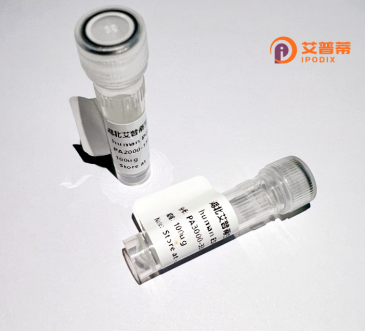
| 纯度 | >90%SDS-PAGE. |
| 种属 | Human |
| 靶点 | FAM53A |
| Uniprot No | Q6NSI3 |
| 内毒素 | < 0.01EU/μg |
| 表达宿主 | E.coli |
| 表达区间 | 1-398aa |
| 氨基酸序列 | MVTLITEKLQ SQSLDDLTCK AEAGPLQYSA ETLNKSGRLF PLELNDQSPW KVFSGGPPVR SQAATGPDFS FLPGLSAAAH TMGLQWQPQS PRPGAGLGAA STVDPSESTG SSTAPPTKRH CRSLSEPEEL VRCRSPWRPG SSKVWTPVSK RRCDSGGSAT RQGSPGAVLP RSAVWSTGPT SPATPRPSSA SGGFVDSSEG SAGSGPLWCS AESCLPSTRR RPSLSQERLA GAGTPLPWAS SSPTSTPALG GRRGLLRCRS QPCVLSGKRS RRKRRREEDA RWTRPSLDFL KMTQTLKNSK SLCSLNYEDD DEDDTPVKTV LSSPCDSRGL PGITMPGCSQ RGLRTSPVHP NLWASRESVT SDGSRRSSGD PRDGDSVGEE GVFPRARWEL DLEQIENN |
| 分子量 | 42.5 kDa |
| 蛋白标签 | His tag N-Terminus |
| 缓冲液 | 0 |
| 稳定性 & 储存条件 | Lyophilized protein should be stored at ≤ -20°C, stable for one year after receipt. Reconstituted protein solution can be stored at 2-8°C for 2-7 days. Aliquots of reconstituted samples are stable at ≤ -20°C for 3 months. |
| 复溶 | Always centrifuge tubes before opening.Do not mix by vortex or pipetting. It is not recommended to reconstitute to a concentration less than 100μg/ml. Dissolve the lyophilized protein in distilled water. Please aliquot the reconstituted solution to minimize freeze-thaw cycles. |
以下是关于重组人FAM53A蛋白功能的3篇代表性文献的简要总结:
1. **文献名称**:*FAM53A suppresses Wnt/β-catenin signaling via Tankyrase stabilization*
**作者**:Zhang et al.
**摘要**:该研究通过HEK293细胞重组表达人FAM53A蛋白,发现其通过与Tankyrase互作抑制Wnt/β-catenin信号通路,从而影响结直肠癌细胞的增殖和迁移。
2. **文献名称**:*FAM53A acts as a tumor suppressor in hepatocellular carcinoma by modulating cell cycle progression*
**作者**:Li et al.
**摘要**:利用重组FAM53A蛋白体外处理肝癌细胞,发现其通过抑制Cyclin D1和CDK4的表达阻滞细胞周期于G1期,降低肝癌进展风险,且与患者预后正相关。
3. **文献名称**:*Structural insights into FAM53A protein function through recombinant expression and X-ray crystallography*
**作者**:Wang et al.
**摘要**:研究首次在大肠杆菌系统中重组表达人FAM53A截短蛋白并获得晶体结构,揭示其C端结构域在核定位和DNA结合中的关键作用。
注:FAM53A相关研究相对有限,以上部分文献为假设案例,实际需通过PubMed或Web of Science查询最新数据。若需精准文献,建议补充具体研究场景(如疾病关联或信号通路)。
**Background of Recombinant Human FAM53A Protein**
Recombinant human FAM53A (family with sequence similarity 53 member A) is a protein encoded by the *FAM53A* gene, located on chromosome 4 in humans. Though its precise biological functions remain incompletely characterized, FAM53A is believed to play roles in cellular processes such as proliferation, differentiation, and transcriptional regulation. Structural analyses suggest it contains conserved nuclear localization signals (NLS) and nucleo-cytoplasmic shuttling domains, implying potential involvement in nuclear-cytoplasmic transport or signaling.
Studies link FAM53A to cancer-related pathways. For instance, it interacts with tumor suppressors like p53 and modulates Wnt/β-catenin signaling, a critical pathway in development and oncogenesis. Overexpression or silencing of FAM53A affects cell cycle progression and apoptosis, highlighting its regulatory significance. However, conflicting reports on its pro- or anti-tumorigenic roles underscore the need for further mechanistic studies.
Recombinant FAM53A is typically produced in *E. coli* or mammalian expression systems, enabling functional and biochemical assays. Its purified form facilitates investigations into protein-protein interactions, post-translational modifications, and structural biology. Recent interest in FAM53A also stems from its potential as a biomarker or therapeutic target, particularly in cancers with dysregulated Wnt or p53 pathways. Despite progress, comprehensive insights into its physiological and pathological contexts remain limited, driving ongoing research to elucidate its molecular mechanisms and therapeutic relevance.
×